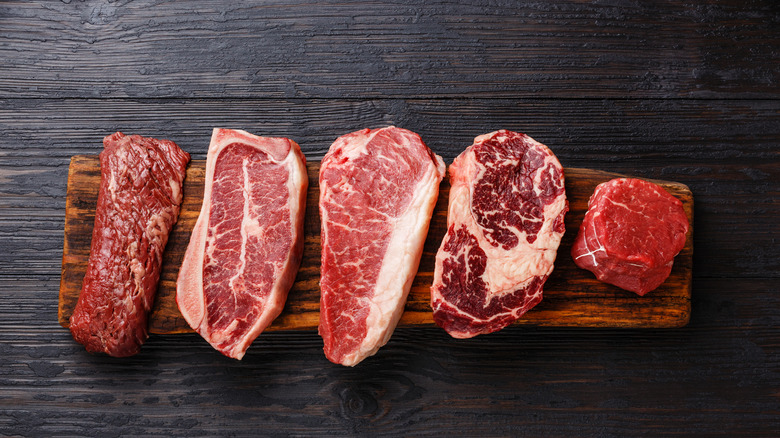What Does It Mean When You Bloom A Steak?
When oxygen meets food, they generally don't get along well. That's because it spurs reactions that often lead to spoilage, be it the brown in an apple, mold on bread, or rancid flavor in nuts. In meat, however, oxygen exposure can raise the game. The process is called "blooming" and reflects the positive connotation the practice has gained with chefs everywhere. That's because the open air warms the meat and brings out the red, rosy color. Indeed, fresh cut meat is purple owing to the lack of oxygen and takes exposure to it to transform into the cherry red that spurs the salivating in meat lovers.
The culprit is myoglobin, a protein pigment inside, or, more precisely, the iron in the myoglobin. When oxygen encounters the meat, the iron in the myoglobin turns red, just as it does in rust on metal and in human blood. This blooming can happen relatively quickly — between 10 and 30 minutes depending on size, cut, and other factors. It's also exceptionally easy to do, as all it takes is leaving the meat out before cooking. Just make sure it's room temperature, as the warmer air relaxes and opens the meat more than cold air. Taking it out of any packaging is a must, too, so the oxygen can contact the meat, so be sure to add blooming before trying the best techniques to cook popular cuts of beef.
Bloom factors to consider
How much your beef blooms can depend on a few other factors, too. Firstly, older animals generally contain more myoglobin in their muscle, creating a deeper red color. That's why young beef, like veal, remains a pale pink even with blooming. The same goes for cows that got lots of exercise, which may be why studies show grass-fed beef has more myoglobin and higher levels of oxidation than grain-fed. Packaging may also contribute, as air-tight seals should keep the meat from blooming and signal greater freshness.
What goes up must come down, however, and the same goes for blooming. After a certain amount of time, oxygen exposure on meat turns a corner and starts down a rancid road you don't want follow. This direction is usually signaled when the red blooming begins to turn brown, although it can still take some time to spoil the beef. It also tends to work from the outside-in, making it easy to trim away. Nevertheless, the USDA considers any meat left open to the air for more than two hours to be in the danger zone, and one hour if the temperature is above 90 degrees Fahrenheit. This makes it essential to keep a close eye on any meat blooming and move it into refrigeration if something takes you away. Blooming is a technique that extends beyond meat, too. For example, what does it mean to bloom coffee? And why should you bloom cocoa powder?

